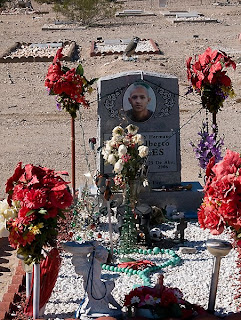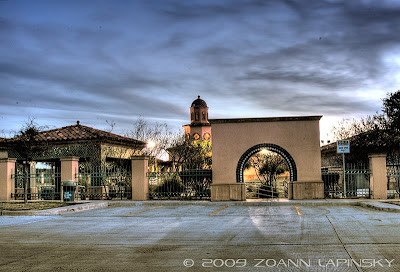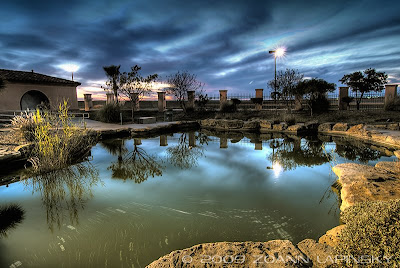Location: Marfa, Texas
 They are the stuff of legend and lore: mysterious balls of light that float near Marfa, Texas. We went out at dusk to see them at a viewing platform set up just for that purpose, about 10 miles east of Marfa itself. The platform stood alone amid miles and miles of nothing but desert scrub and dried grass, looking out over an Army airfield that was abandoned in 1945. Two restrooms, three mounted binoculars (impossible to focus accurately due to excessive usage, but amazingly operational without feeding a coin slot), a large viewing platform, and lots of parking was all that was there -- and about a dozen people, all waiting for sunset and a chance to see "The Lights."
They are the stuff of legend and lore: mysterious balls of light that float near Marfa, Texas. We went out at dusk to see them at a viewing platform set up just for that purpose, about 10 miles east of Marfa itself. The platform stood alone amid miles and miles of nothing but desert scrub and dried grass, looking out over an Army airfield that was abandoned in 1945. Two restrooms, three mounted binoculars (impossible to focus accurately due to excessive usage, but amazingly operational without feeding a coin slot), a large viewing platform, and lots of parking was all that was there -- and about a dozen people, all waiting for sunset and a chance to see "The Lights."
Some "facts" about the Marfa Lights:
- They only show 10-12 times a year; they show 50-60 times a year; they show every night if it is clear; they show every night but slack off around midnight.
- They are mostly white; they are white, blue, green, red and yellow; they sometimes float; they sometimes follow cars.
- They were seen by early Native Americans and people heading west on wagon trains; they have only been seen in recent times and the reports of early sightings are apocryphal.
- During World War II, the men at the now-closed airfield didn't see them; the airmen all saw them from the ground but pilots couldn't see them from the air.
- They are caused by swamp gas; they are caused by a mirage due to the area's extreme temperature gradients; they are caused by quartz crystals expanding and contracting, the accumulating voltage discharging as ball lightning.
- Scientists from NASA have swarmed over the site and couldn't find anything; scientists from Japan spent over a month there, but no one seems to know what they found; it is difficult to study them because the site is on private land so serious studies can't be done; two scientific studies were done (by students at the University of Texas and by something called the Aerial Hyperspectral and Reflection Study), and both found that most to all of the lights are associated with car headlights on nearby Highway 67.
As soon as it was reasonably dark, we looked toward the mountains and saw... lights! They were white, shimmery, and slowly increased or decreased in brightness, some twinkling out, some staying bright, and some slowly moving. Some were high, some low. This photo (click to enlarge) shows the lights -- note that the red light on the left is a known radio tower, and not part of the Marfa Lights:

It was pretty exciting, and everyone was getting jazzed watching the lights and speculating about their origin. However, I have to say that I am totally convinced that we were seeing car lights. Here is a map showing the relative location of the viewing station and Highway 67 (I have not been able to pinpoint the mountains on this map, but the blue arrow shows the direction of view), and it shows that Highway 67 is in a direct line of sight from the platform. And, as this next photo shows, when viewed in a longer time-exposure photo the lights were situated a straight line, they all moved along that line, and some red smudges (taillights) can be seen following the white headlights, just as you would expect cars lights on a road to look (click to enlarge):

But nothing is ever that simple -- for that was not all we saw. When we looked to our left, we saw three other lights that seemed much closer, perhaps as near as the abandoned airfield, although if they were large they could have been further away. They were bluish and faint, never changing brightness or location. I have seen no other mention of them in Marfa literature. One report said that locals know the lights against the mountains are just car lights, and the rarely seen "real" Marfa Lights are totally different and unexplainable.
Who knows what our three lights were? Left-over reflectors? Once the sun set, the only light sources were the quarter moon and Venus, and they didn't seem to be in the right part of the sky to bounce their light off reflectors in that area. It was impossible to get a good photo of them, because there was nothing around them to show as a background or to give scale -- but I'll share the photo I did get, with the note that the photo makes them appear brighter and more distinct than they did to the eye (the white dot at the top is a star):

No matter how many photos are taken or studies are done, there will never be an adequate explanation of the Marfa Lights for those who want to believe in the supernatural. I, however, am going with car lights to explain the lights on the mountain, and I'll just file the three other lights under Mystery Yet To Be Solved. But whether you think they are car lights, swamp gas, electrical energy, or aliens visiting earth, they were lovely and it is worth an evening to go see them.















































